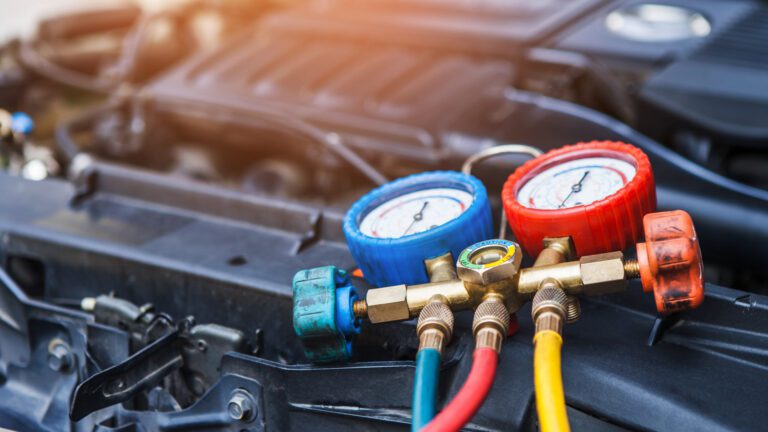Difference Between R12 and R134 refrigerant
Proper handling of the air-conditioning (A/C) system during collision repair is one of the most important and least understood aspects of working with mechanical components. Many needless repairs are caused unknowingly by service technicians who do not understand the importance of following some strict rules for working with A/C systems. What compounds the problem is that malfunctions often occur several months after the collision repair work is completed, so the customer is unaware of who caused the problem.
A/C OPERATION
An air-conditioning system is designed to cool the passenger compartment. Although designs vary somewhat, all
automotive A/C systems use similar operating principles.
The major parts of a modern A/C system are shown in this Picture :
An air-conditioning compressor is an engine-driven pump that forces the refrigerant through the system. Lines and hoses carry the refrigerant to the different parts of the
system. The condenser transfers refrigerant heat to the outside air. It is normally located in front of the radiator. It is constructed like a radiator, with core tubes and metal fins.
The evaporator draws warm air out of the passenger compartment to provide a cooling effect. It is normally located under the dash. It is also like a small radiator.
A receiver/drier or an accumulator uses a desiccant bag to remove moisture from the system. The only difference between them is their location. The accumulator
is found between the evaporator and compressor.
The receiver/drier is located between the condenser and expansion device. Both act as storage tanks. An expansion valve, or orifice tube, causes the refrigerant pressure to drop to produce a cooling action in the evaporator.


REFRIGERANTS
Due to its possible depleting effect on the Earth’s ozone layer, R12 refrigerant is being phased out. Environmental regulations call for a gradual phase-out of most ozonedepleting substances. They allow R12 systems to be serviced using recovered and recycled refrigerant. After filtering, R12 can be used again in another vehicle. Such reuse
is designed to extend the supply of refrigerant. R134a is the present replacement refrigerant for R12. It is less harmful to the ozone layer. New vehicles are being Mixing of R12 and R134a, even in trace amounts, can be fatal to a system. This mistake can cause damage to seals, bearings, compressor reed valves, and pistons. Mixing refrigerants can also cause desiccants used in R12 systems to break down and form harmful acids.












